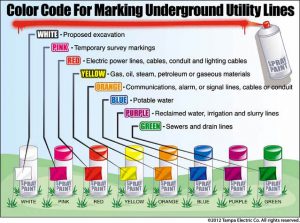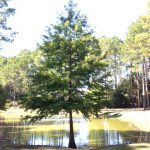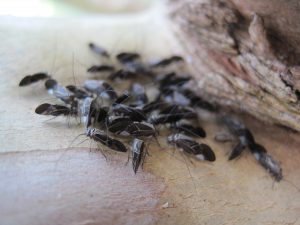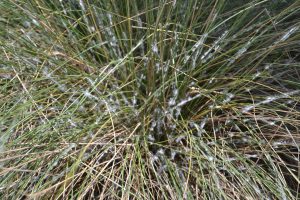April is National Safe Dig Month
 This month, recognized by the Senate and Florida’s governor, reminds diggers why calling 811 before all outdoor digging projects is important to your safety. Before installing a mailbox, fence, deck, garden or tree make sure to call Sunshine 811 to have underground lines marked. 811 is the free national number designated by the Federal Communications Commission. It notifies utility companies, who in turn send their professional locators to identify and mark the appropriate location of underground line with paint and flags in colors that identify the utility type. The following colors represent the seven various utilities: red, orange, blue, green, yellow, purple and white. To see which colors correspond with each utility click on the picture below:
This month, recognized by the Senate and Florida’s governor, reminds diggers why calling 811 before all outdoor digging projects is important to your safety. Before installing a mailbox, fence, deck, garden or tree make sure to call Sunshine 811 to have underground lines marked. 811 is the free national number designated by the Federal Communications Commission. It notifies utility companies, who in turn send their professional locators to identify and mark the appropriate location of underground line with paint and flags in colors that identify the utility type. The following colors represent the seven various utilities: red, orange, blue, green, yellow, purple and white. To see which colors correspond with each utility click on the picture below:
Hitting an underground utility line while digging can cause injuries, utility service outages to an entire neighborhood and damage to the environment. Failure to call before digging results in one unintentional utility hit every eight minutes nationwide. You could also be financially affected with costly fines and high repair costs.
Calling 811 in Florida is the law. At least two full business days before digging, do-it yourselfers and professional excavators must contact 811 by phone to start the process of getting underground utility lines marked. This is a free service. Be sure that all utilities have been marked before grabbing the shovel. Follow up on your one call ticket by contacting 811 again on the third day. For more information on Florida’s law, visit www.Sunshine811.com.
Celebrate Arbor Day
The best time to plant a tree is twenty years ago. The second best time is Arbor Day. Florida recognizes the event on the third Friday in January, but planting any time before spring will establish a tree quickly.
Arbor Day is an annual observance that celebrates the role of trees in our lives and promotes tree planting and care. As a formal holiday, it was first observed on April 10, 1872 in the state of Nebraska. Today, every state and many countries join in the recognition of trees impact on people and the environment.
Trees are the longest living organisms on the planet and one of the earth’s greatest natural resources. They keep our air supply clean, reduce noise pollution, improve water quality, help prevent erosion, provide food and building materials, create shade, and help make our landscapes look beautiful. A single tree produces approximately 260 pounds of oxygen per year. That means two mature trees can supply enough oxygen annually to support a family of four.
The idea for Arbor Day in the U.S. began with Julius Sterling Morton. In 1854 he moved from Detroit to the area that is now the state of Nebraska. J. Sterling Morton was a journalist and nature lover who noticed that there were virtually no trees in Nebraska. He wrote and spoke about environmental stewardship and encouraged everyone to plant trees. Morton emphasized that trees were needed to act as windbreaks, to stabilize the soil, to provide shade, as well as fuel and building materials for the early pioneers to prosper in the developing state.
In 1872, The State Board of Agriculture accepted a resolution by J. Sterling Morton “to set aside one day to plant trees, both forest and fruit.” On April 10, 1872 one million trees were planted in Nebraska in honor of the first Arbor Day. Shortly after the 1872 observance, several other states passed legislation to observe Arbor Day. By 1920, 45 states and territories celebrated Arbor Day. Richard Nixon proclaimed the last Friday in April as National Arbor Day during his presidency in 1970.
Today, all 50 states in the U.S. have official Arbor Day, usually at a time of year that has the correct climatological conditions for planting trees. For Florida, the ideal tree planting time is January, so Florida’s Arbor Day is celebrated on the third Friday of the month. Similar events are observed throughout the world. In Israel it is the Tu B Shevat (New Year for Trees). Germany has Tag des Baumes. Japan and Korea celebrate an entire week in April. Even Iceland, one of the treeless countries in the world observes Student’s Afforestation Day.
The trees planted on Arbor Day show a concern for future generations. The simple act of planting a tree represents a belief that the tree will grow and someday provide wood products, wildlife habitat, erosion control, shelter from wind and sun, beauty, and inspiration for ourselves and our children.
“It is well that you should celebrate your Arbor Day thoughtfully, for within your lifetime the nation’s need of trees will become serious. We of an older generation can get along with what we have, though with growing hardship; but in your full manhood and womanhood you will want what nature once so bountifully supplied and man so thoughtlessly destroyed; and because of that want you will reproach us, not for what we have used, but for what we have wasted.”
~Theodore Roosevelt, 1907 Arbor Day Message
Green Industry Training Classes
Please check out our Upcoming Events page to see what classes are offered in the Panhandle for Green Industry Professionals.
If you’d like to have emails about upcoming events sent directly to your inbox, sign up for our newsletter at Subscribe UF/IFAS select “Green Industries in the Panhandle” under the “Lawn & Garden” tab.
2016 Formosan Termite Swarm Report
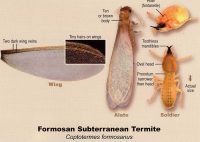 The genus Coptotermes contains the largest number of termite pests (28 species) worldwide, with the Formosan subterranean termite, Coptotermes formosansus, being the most widely distributed and most economically important. During the 1960’s it was found in Texas, Louisiana, and South Carolina. The first well-established colony in Florida was reported in 1980.
The genus Coptotermes contains the largest number of termite pests (28 species) worldwide, with the Formosan subterranean termite, Coptotermes formosansus, being the most widely distributed and most economically important. During the 1960’s it was found in Texas, Louisiana, and South Carolina. The first well-established colony in Florida was reported in 1980.
A single colony of Formosan subterranean termite may contain several million termites that forage up to 300 feet in soil. Once established, the Formosan subterranean termite has never been eradicated from an area. Therefore, monitoring of movement of the species is critical. Beginning in 2015, the Florida Department of Agriculture of Consumer Science (FDACS) began trapping the alates. Termites have three primary castes: the reproductive, soldiers, and workers. Within the reproductive caste, the young females, referred to as alates, are the ones that leave the colony. They are able to form wings and seek new areas to become established. Dispersal flights or “swarms” are massive and begin at dusk on calm and humid evenings from April to July. Alates are attracted to lights.
The objective of the FDACS Formosan Termite Alate project is to trap alates throughout the four most western counties of the Panhandle during their major swarm season in May and June, which is the time they are most active in that part of Florida. Trapped alates were counted on a weekly basis to determine peak swarming weeks. White, gridded 7”x 4” sticky card attached to 6’ stakes are placed under strong, predetermined street lights. Twenty-two trap locations were selected, each representing a key Panhandle community with at least one location North of I-10 within each of the four counties.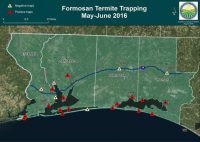
In 2016, sixteen out of the 22 traps were positive for Formosan termite alates throughout the four Panhandle counties. Formosan alates were caught during 7 of the 8 weeks of trapping. The largest spike in numbers trapped was during the week of May 8th. A subsequent swarming spike occurred during the week of May 22nd. Trap locations that were positive in 2016 and not 2015 included Pensacola Beach, Destin, Blue Mountain Beach, Okaloosa Island and Choctaw Beach. The project will be continued each year in order to determine some of the problem areas.
For more information go to:
http://www.freshfromflorida.com/Divisions-Offices/Agricultural-Environmental-Services/Consumer-Resources/Protect-Your-Home-from-Pests/Termites/Formosan-Termite-Program
Should a Red Maple be Planted There?
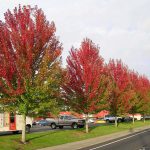 Red Maples are among the most frequently planted urban trees. Many of its features, especially its leaves are quite variable in form. Its flowers, petioles, twigs and seeds are all red to varying degrees. But, it is best known for its brilliant deep scarlet foliage in autumn. Red Maple is adaptable to a wide range of site conditions, perhaps more so than any other tree in eastern North America. It can be found growing in swamps, on poor dry soils, and most anywhere in between. However, the tree health and appearance decreases when trees have more impervious surfaces around them.
Red Maples are among the most frequently planted urban trees. Many of its features, especially its leaves are quite variable in form. Its flowers, petioles, twigs and seeds are all red to varying degrees. But, it is best known for its brilliant deep scarlet foliage in autumn. Red Maple is adaptable to a wide range of site conditions, perhaps more so than any other tree in eastern North America. It can be found growing in swamps, on poor dry soils, and most anywhere in between. However, the tree health and appearance decreases when trees have more impervious surfaces around them.
North Carolina State University research has developed the impervious surface threshold (http://content.ces.ncsu.edu/impervious-surface-threshold-for-sustainable-urban-tree-planting-and-landscaping-design) which can be used to identify planting sites where Red Maple will thrive. Landscape architects, urban planners, arborists, landscapers, and other professionals can use these impervious surface thresholds to reduce Red Maple management and replacement costs.
Trees surrounded by less than 33% impervious surface cover will most likely be in good or excellent condition. Trees surrounded by 33%-66% are likely to be in fair condition. Trees surrounded by 67% or more tend to be in poor condition. Impervious surface cover can be measured by using the “Pace to Plant” technique.
The “Pace to Plant” technique is a tool to quickly and accurately quantify the amount of impervious surface surrounding a tree or planting site. Begin by standing at the planting site and identify the closest impervious surface edge. Take 25 steps at 45⁰ to the nearest impervious edge, counting only the steps that land on the impervious surface. Then, return to the identified planting site and begin walking 25 steps in the opposite direction. Again, only count the steps that fall onto impervious surface. If you encounter a building or wall, count the remainder of the steps as impervious. One more time, return to the starting planting site. This time turn 90° and begin walking 25 steps and count the steps that fall onto impervious surface. Finally, turn around and go back to the planting site and begin walking in the opposite direction for 25 steps. This will be the fourth time that steps falling onto the impervious surface are counted. Having walked in four directions located 90° from each other, completing an “X” through the planting site, the transect is final with a total of 100 steps have been taken. By totaling the number of steps that fall onto impervious surfaces the percentage of the surrounding ground area can be determined. For example, if the total number of steps falling on impervious surface is 65 (out of the potentially 100 steps), the percentage of impervious surface is 65%. Using the established criteria, the site would not be suitable for planting a Red Maple.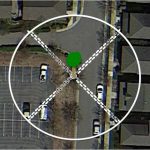
While North Carolina State has only researched the Red Maple tree species, the “Pace to Plant” technique could be used to determine suitable sites for many different trees being considered for commercial urban planting.
By evaluating the impervious surface restrictions, better tree species selection may be possible. If the right tree for the right place is chosen well, stress to urban trees, including pest infestations, can be reduced.
Growing Healthy Palms Workshop

University of Florida palm and disease Extension specialist Dr. Monica
Elliott will share information on palm installation and best management
practices.
- Timing and techniques for proper palm planting.
Establishing and care for palms through proper watering,
fertilization, and pruning. - Learn the cold hardy palms to plant along the Gulf Coast and
palm issues and diseases associated with cold weather
injury. - Where to focus your palm care when funds are limited.
Wednesday July 27, 2016
Pensacola (10-11:45am), Escambia County Central Office Complex, 3363 West Park Place Pensacola, FL 32505
REGISTER: Program is free but register for a spot by calling 475-5230 or emailing bbolles@ufl.edu
Santa Rosa Beach (3-4:45pm), Walton County Extension Annex 70 Logan Ln, Santa Rosa Beach, FL 32459
REGISTER: Program is free but register by calling 850-892-8172 or emailing haneyc@ufl.edu
CEUs to be available
Cattle Grazing on My Trees…
Cattle aren’t really grazing on the trees (this time), but tree cattle (a.k.a. bark lice) are grazing on the trees. The scientific name for tree cattle is Cerastipsocus venosus. Adults have shiny black wings that are held at a sharp angle resembling an old style camping tent or an F-117 Nighthalk stealth fighter. Wingless adults also exist.
The nymphs have an ovate abdomen with dark gray and light yellow banding similar to a honeybee. A related species, Archipsocus nomas, is known to produce unharmful webbing that covers the trunk and branches of trees, but not the leaves.
These insects are usually seen in a colony containing a mixture of nymphs and adults. Unlike hair lice, bark lice are not parasites and are classified as beneficial insects. Unlike most beneficial insects, they do not feed on other insects. Instead, they clean the bark by eating excess accumulations of fungi, algae, lichens, dead bark, and other nonliving material. Tree cattle are not bark borers and do not eat leaves or living bark.
They are often seen on crape myrtles, but have been reported to graze on oaks and Bradford pears. Bark lice are more prevalent during hot and humid summer months.
Tree cattle are classified as beneficial, therefore no management is required. Because clientele may consider the term beneficial insect to be an oxymoron, it is important to supply supplemental educational materials to back up your claim. Publications are available from Clemson University and Auburn University.
It is time to monitor for Rose Rosette Disease in Florida
Author: Dr. Mathews Paret
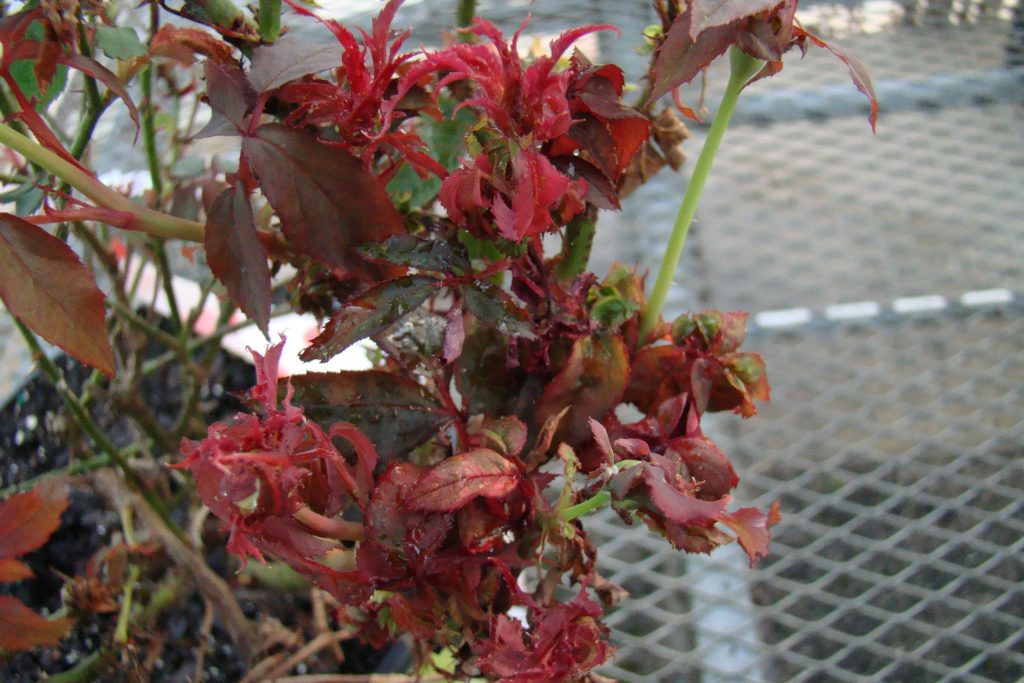
Rose Rosette (Photo Credits: Mathews Paret)
Caused by: Rose rosette virus (Currently not present in Florida; but previously discovered in three counties in Florida in 2013 and 2014 led to the successful destroyal of the infected plants)
Vectored by: An eriophyid mite species; Phyllocoptes fructiphilus (Not known to be present in Florida). Grafting or budding can also transmit the virus from infected to healthy plants
Why is monitoring for rose rosette disease in Florida important?
- Currently, Florida is the state with the largest value in wholesale production of roses in the U.S ($29.7 million)
- The landscaping industry in Florida heavily uses roses and especially shrub roses.
- The disease can affect all varieties of roses
- Currently, there is no known cure for Rose Rosette Disease, and hence early detection and eradication of infected plants is the key to prevent any establishment of the disease in Florida
Thus, monitor and report to the county extension agent or University of Florida, Plant Pathology Lab at NFREC, Quincy if suspicious plants are noted. This is critical in ensuring that Florida roses are well protected this year and in the coming years from Rose Rosette Disease.
Symptoms of the disease and details of the virus can be found in the following documents.
Rose Rosette Disease: A new disease of roses in Florida
http://edis.ifas.ufl.edu/pdffiles/PP/PP31700.pdf
IFAS Pest Alert: Rose Rosette Virus
http://programs.ifas.ufl.edu/u-scout/Alert_files/RRV_PestAlert_Paret_2014.pdf
Relevant information on all major diseases of roses in Florida can be also found at U-scout website of NFREC, University of Florida
http://programs.ifas.ufl.edu/u-scout/Rose/Rose.html
Contact person:
Mathews Paret
Assistant Professor, Plant Pathology
University of Florida, NFREC, University of Florida paret@ufl.edu, 850-875-7154
Muhly Grass Pest
Muhly grass (Muhlenbergia capillaris) is a generally pest free plant in our area, however, we are seeing the native mealybug, Stemmatomerinx acircula, on plants in various landscapes. Insects are on the leaves and are grey with white wax that may have some filaments. You may also see long ovisacs on the leaves which contain eggs and crawlers. The native fakahatchee grass may also be a host.
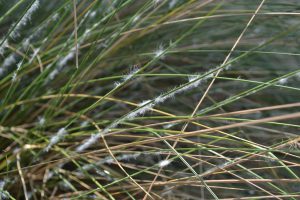
The mealybug is white with fine filaments and numerous mealybugs can be found each leaf. Photo: Beth Bolles
The common practice of right plant, right place does not always prevent the mealybug infestations on muhly grass. Specimens in both full and shade can be affected, as well as mass plantings and those spaced out. At this time, there is not a lot of information on why some plantings are heavily infested and others are not.
Since mealybugs are piercing sucking insects, there may be some browning of leaves, especially on less vigorous plants. You may have to remove and destroy plants that are heavily infested and declining. In situations where treatment is warranted you may choose a systemic insecticide or oil spray to keep plants looking more attractive. As the landscape manager, you will need to decide what is an acceptable threshold for this pest.
Too Late yet Too Early
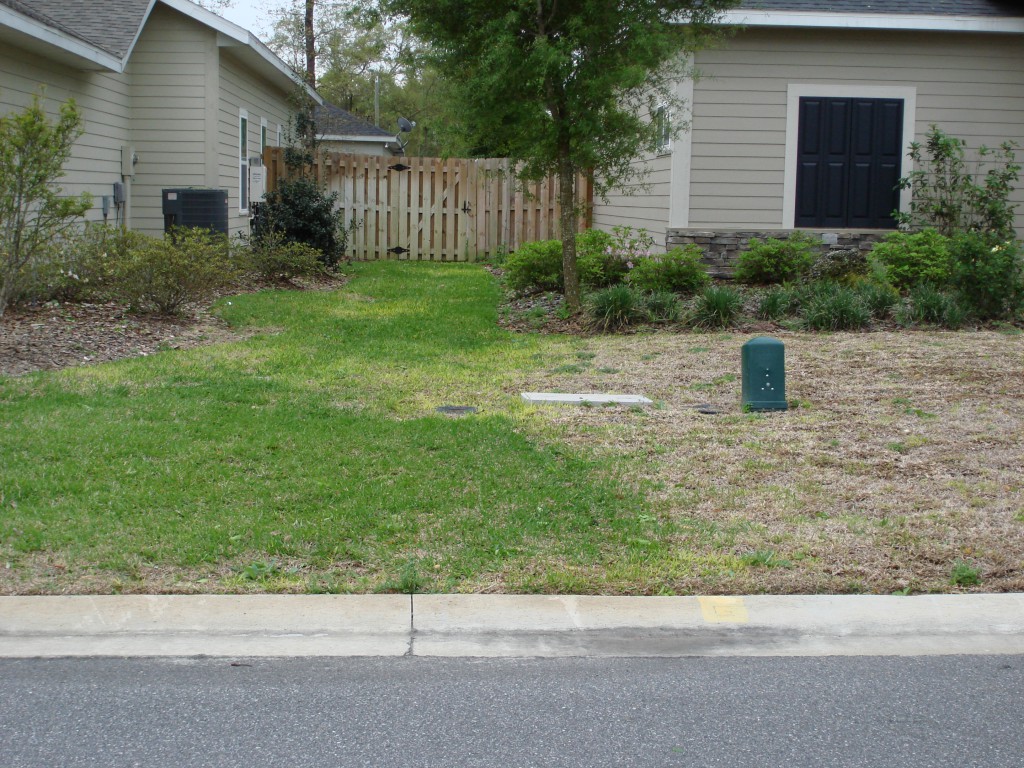
Winter kill. Photo Credit: J. Bryan Unruh
Author: J. Bryan Unruh, Ph.D. – Extension Turf Specialist
Spring has sprung! With that comes the urge to ramp up spring landscaping projects – planting a garden; replenishing the mulch in the beds; planting summer annuals for color; preventing that nasty crabgrass from germinating; and fertilizing the lawn. STOP! WAIT! TIMEOUT!
“Weed-and-Feed” products are commonly marketed in most garden centers and box stores. However, the use of weed-and-feed products should largely be avoided in Northwest Florida. Here’s why. In northwest Florida, crabgrass typically germinates around March 1st – give or take a couple of weeks based on spring conditions (warmer = earlier) or whether you reside along the coast or in the northern reaches of your county. Consequently, with March almost behind us, we are beyond the window of opportunity to control crabgrass before it germinates. Crabgrass control measures now must rely on postemergence (after the weed germinates) options. For all of our turfgrasses, except Bahiagrass and St. Augustinegrass, a number of options are available. Refer to https://edis.ifas.ufl.edu/EP141 for more information. There are no postemergence crabgrass herbicides registered for use on St. Augustinegrass!
The “feed” side of “weed-and-feed” provides plant nutrition – through the application of fertilizer. However, UF/IFAS does not recommend lawn fertilization prior to April 15th in northwest Florida. There are a couple of reasons why UF/IFAS doesn’t recommend early spring fertilization. First, it is very common for portions of northwest Florida to experience heavy frosts through March and into the first week of April. We desire for the turf to remain “at rest” until after the first week of April. Fertilizing prior to April 15th nearly guarantees that the lawn will be awakened making it prone to severe damage should a late spring frost occur (Figure 1). Second, UF/IFAS scientists hypothesize that the turfgrass root system (the part you can’t see) lags behind the shoot system (the part you can see). When fertilizer granules are applied to the lawn, the granules dissolve and the nutrients become part of the soil solution (soil water + dissolved substances). Liquid applied fertilizers go directly into the soil solution. If the root system is not ready to absorb the nutrients, the nutrients are likely to leach below the rootzone and can potentially move into the groundwater as a pollutant. UF/IFAS research conducted near Pensacola and south of Gainesville conclusively showed that fertilizer applied around March 1st had elevated nutrient leaching. Conversely, when fertilizer is properly applied to a healthy lawn, the turf will assimilate all the applied nutrients and not cause environmental problems.
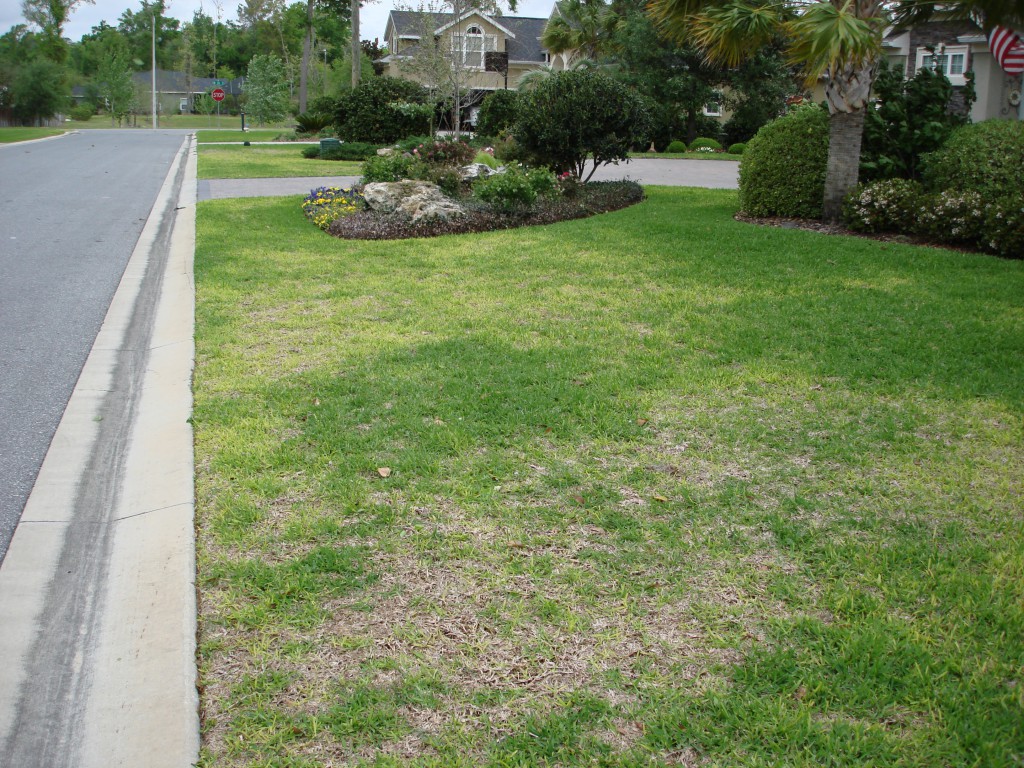
Patchy winter kill. Photo Credit: J. Bryan Unruh
What about “weed-and-feed” products for broadleaf weeds such as dollarweed (https://edis.ifas.ufl.edu/EP389) or Virginia buttonweed (https://edis.ifas.ufl.edu/EP386)? Generally, these weeds do not inhabit the entire property – they appear only in patches scattered throughout the lawn. Why then, would you apply chemicals to an entire lawn when only a small area needs to be treated? The answer is simple – you shouldn’t. Under this scenario, it would be best to use “Ready-to-Use” products or make a mix from a concentrated product and deliver through a pump-up type sprayer.
Bottomline – go ahead a start your spring gardening. Plant your garden. Refresh the plant beds. Plant those annuals and perennials to give you the color you want. If you haven’t fertilized yet – great. Wait until mid-April or later. If you have already fertilized and your lawn is green – hope that we don’t get a late-season frost!
